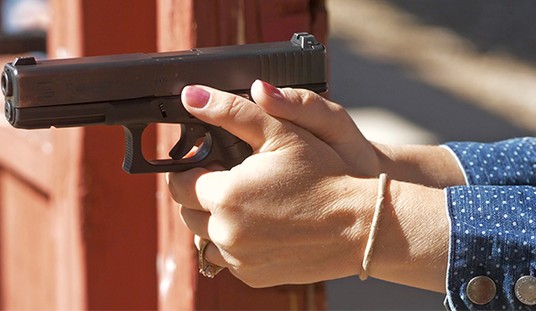I’ve been cheering Milwaukee Journal-Sentinel reporter John Diedrich and his series “Behind the Gun” for providing a nuanced and balanced approach to talking about “gun violence” in its many forms, in part because it’s so incredibly rare to see that kind of balance in mainstream media reporting. Far too often what we get is a one-sided approach that starts with the premise that gun ownership is bad, gun control is good, and we need less of the former and much more of the latter.
That narrative is on full display in a recent report from the Oklahoma-based news site The Frontier, which asks whether the state’s “anti-red flag law” played a role in a brutal attack on a woman by her ex-boyfriend. The short answer is “no”, but reporter Ashlynd Huffman spills a lot of ink trying to make the case that the shooting never would have happened if the state had an Extreme Risk Protection Order law in place.
Robert Lee Harrison Jr. was charming when Tara Currin first met him at an Oklahoma City bar, but things turned dangerous when he started using drugs about a year into their relationship.
Harrison, 50, became verbally abusive and accused Currin, 53, of hiding cameras around her apartment, she said.
She knew she had to break up with Harrison when he crept up behind her with a gun and shot into the wall at her apartment in Warr Acres.
“I wasn’t scared of Robert,” she said. “I was afraid of him when he had a gun.”
Harrison had three prior felony convictions, a misdemeanor conviction for domestic abuse and two active protective orders against him that should have kept him from possessing guns under state and federal laws. He also had two pending criminal charges against him for possessing a firearm after a prior felony conviction and was out of jail on bond.
But none of these things kept Harrison from hiding in the parking garage with a gun at the Oklahoma City hospital where Currin worked and shooting her eight times on March 11, 2022.
If Currin had lived in one of 21 states with a red flag law, a judge could have ordered police to seize Harrison’s guns. But Oklahoma lawmakers passed the nation’s first and only anti-red flag law in 2020. The law bans the state, county or any city from enacting a red flag law or accepting any grants to support red flag legislation.
Huffman admits that Harrison wasn’t legally allowed to possess a gun to begin with, so why does she believe that a “red flag” law would have done a better job of disarming him than his previous convictions or the protective orders that a judge granted Currin?
Extreme Risk Protection Orders typically block someone from legally purchasing a firearm at retail, and if they currently own any firearms they can be removed from the home; either by law enforcement or, in some cases, by a third party approved by the gun owner. But for someone like Harrison, who illegally possessed a gun, an Extreme Risk Protection Order would be of little consequence since he was already prohibited from legally purchasing or possessing a firearm.
Currin believes a red flag law could have prevented her attack. The court could have granted a search warrant for police to seize any weapons. Tara Tyler, executive director of the domestic violence support agency Survivor Resource Network in Ponca City, believes limiting abusers’ access to firearms could help save lives.
“There’s no question that unfettered, unrestricted gun access negatively impacts public safety,” she said. “And I say that as a gun owner.”
There is usually a pattern of escalating violence before most intimate partner homicides, said Sarah Schettler, a spokeswoman for the Norman Police Department.
“If those who have convictions early have firearms removed, lethal events may not be as likely to occur,” Schettler said.
A red flag law could be another tool to help law enforcement prevent homicides, Shettler said.
I suppose it’s possible that if Oklahoma had a red flag law and it was used against Harrison a judge would have signed a search warrant, police would have discovered the illegally possessed gun, and Currin never would have been shot. But I’d say it’s at least as likely that Harrison would have once again bonded out of jail on a charge of felon in possession, would have illicitly acquired a gun as he had done multiple times in the past, and would have targeted his ex regardless of an Extreme Risk Protection Order that had been issued.
My biggest question after reading over Harrison’s criminal history is why he was out on bond, especially for the second charge of illegally possessing a firearm. That seems to me to have been the best chance to disrupt Harrison’s plans, given that he’d shown a habit of getting his hands on a gun whenever he wanted when he was out on the streets. Even if he hadn’t managed to get ahold of a gun, he still could have used a knife or even his fists to brutally assault his ex-girlfriend. It was his freedom to move about in society that led to his attack on his ex, not a lack of a “red flag” law.
No one should have to experience what Tara Currin lived through and lives with every day. The idea that a “red flag” law could have prevented her ex-boyfriend’s attack when multiple orders of protection, pending criminal charges, and various felony and misdemeanor convictions failed to do so, however, is a real stretch of the imagination. At their heart, “red flag” laws are about removing the ability for someone to lawfully acquire or possess a gun. If someone like Harrison turns to the black market or decides to steal a gun instead of trying to buy one, no ERPO law on earth, no matter how tightly crafted, is going to stop them from doing so, and it’s an act of journalist malpractice for Ashlynd Huffman and The Frontier to pretend otherwise.









